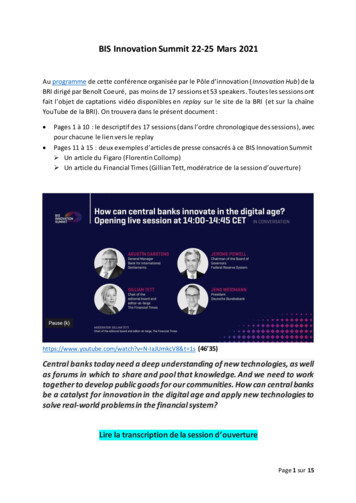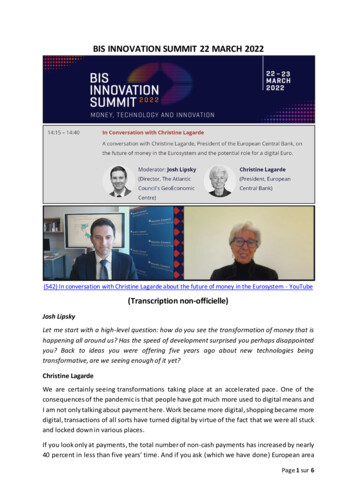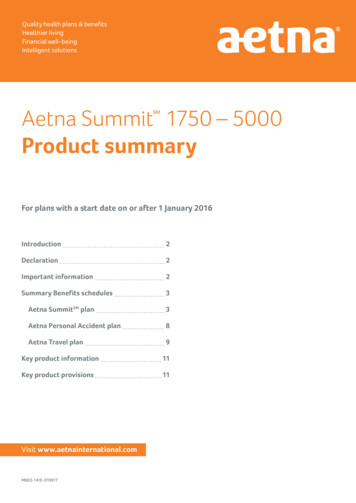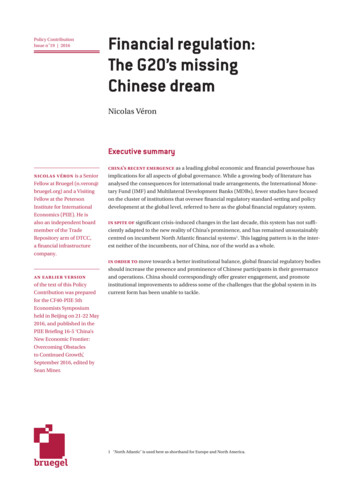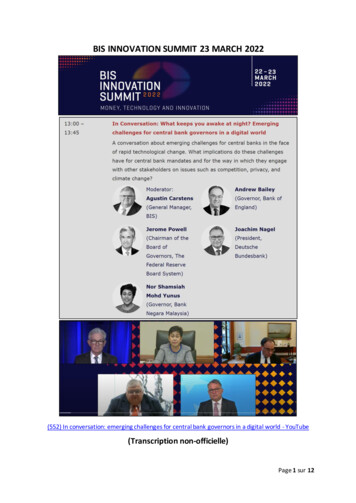
Transcription
BIS INNOVATION SUMMIT 23 MARCH 2022(552) In conversation: emerging challenges for central bank governors in a digital world - YouTube(Transcription non-officielle)Page 1 sur 12
Agustin Carstens (moderator)We are living through an era of unprecedented change in the financial sector. A great attentionis devoted to such emerging trends as the role of big tech in finance, decentralized finance(DeFi) and new forms of private digital money like cryptocurrencies and stablecoins. Thes echanges raise challenges for central banks. Central bankers are working hard to understandthese changes and to decide how to respond. They are looking at the implications of thesechanges for central bank mandates, regulation and the role of central ban k money in thefinancial system of the future.Amongst the important trends that are reshaping the financial system, I mentioned thegrowing power of big tech, the rapid rates rise of DeFi and expansion of cryptocurrencymarkets. Hence, my first question for all of our panelists: which developments do you believeoffer the greatest opportunities for the financial sector, and which of these may be the greatestpotential sources of risk? Jerome, let me start a with you.Jerome PowellYou pointed out that we are in a time of rapid technological change in the financial sector,especially in payments. As it is often the case, there is a mixture of innovations that will havelasting and perhaps salutatory effects, and those that will turn out to be mostly hype. It isnever possible in real time to be sure of which is more fundamentally innovation, the key todriving productivity in the economy. The FED has long supported responsible innovation.Novel technologies like distributed ledger and decentralized finance have the potential toincrease the efficiency of the payment system and encourage a more competitive financiallandscape.The future we can imagine is one featuring ubiquitous real-time payments delivered atextremely low cost. However, it is also easy to see the risks. Our existing regulatoryframeworks were not built with a digital world in mind. Stablecoins, CBDC, and digital financemore generally, will require changes to existing laws and regulation or even entirely new rulesand frameworks under the principle of “same activity, same regulation”.From a consumer protection standpoint, users may not fully understand the extent of theirpotential losses or the fact that these investments generally lack the government protectionsthat accompany many of the traditional financial instruments and services.There also are potential financial stability concerns for some products. In particular, we do notknow how some digital products will behave in times of market stress that could lead to largedestabilizing flows, nor do we know how stresses in crypto markets could potentially spilloverinto the traditional financial system. Moreover, crypto assets have been used in some casesto facilitate illicit activity and we need to prevent this, so that the innovations that survive andattract broad adoption are those that provide value over time and for legal use cases.All of these innovations have made central bankers think critically about the intersection ofmoney, payments and technology, and about the role of central banks in the economy. ThatPage 2 sur 12
is why the FED recently issued a discussion paper on the future of money and payments. Thepaper is intended to be a first step in fostering a broad and transparent public dialogue aboutthe future of money and we look forward to receiving ideas and comments from a wide arrayof stakeholders about what the future of the financial system should look like.As the paper notes, we are actively examining potential use cases, benefits, costs and risks ofa CBDC and while we have not made any decisions on whether we will eventually issue a dollarCBDC or what would be the underlying technological design of it. We did outline four keyprinciples that are currently guiding our thinking: First, a CBDC will need to ensure users privacy. We are researching technological andpolicy options for a robust privacy framework.Second, a CBDC would need to be identity verifiable in order to prevent moneylaundering, terrorism financing and other illicit activity, just as banks and other financialinstitutions currently comply with such rules.Third, we also foresee a CBDC in the US being intermediated, so that it can leverage theprivate sector's ability to innovate as well as the private sector's existing privacy, identitymanagement and AML frameworks. An intermediated CBDC would also lessen financialstability risks that could arise from disintermediation of private sector providers wherefinancial services also provided by the governmentFourth, a CBDC would need to be able to serve as a widely accessible means of paymentfor all transactions, meaning that it would need to be seamlessly transferable and betweencustomers of different intermediates.In any case, digital innovation in the financial sector is here to stay and we are only at thebeginning of this journey.Agustin CarstensThanks Jerome, you have raised very important and interesting issues some related to how fitfor purpose is regulation to the developments of the digital world. At the same time, this is dueto the fact that regulation was not drafted to having in mind this digital world, issues relatedto consumer protection and is very interesting the key principles that are a contemplated inthe in the CBDC document that was just raised on privacy, identity, intermediation andtransferability of these CBDCs. Now, let me turn to Joachim.Joachim NagelGenerally, I think that most of the developments are for the benefit of customers as well asthe providers of financial services. I take for example fintech and big tech companies thatintroduced new financial services. The established financial institutions had to adapt theirproduct portfolio accordingly. Now, most of them provide comprehensive mobile bankingservices that allow customers to conduct financial transaction using for example mobiledevices such as smartphones or tablets, wherever they are.Page 3 sur 12
Likewise, the emergence of crypto tokens and the introduction of distributed ledgertechnology (DLT) have opened up many opportunities. In particular, DLT allows for innovativeapplications at the interface between the financial and the real economies. And withprogrammable payments, completely new business models with fully integrated supply chainsbecome possible.Digitalization can also help us to tackle climate change and climate policies. In order todetermine the right measures, we need a solid database of climate financial data. Digitaltechnologies such as artificial intelligence or, for example, process optimization, enable us togather and analyze the relevant data in a cost-efficient way.Finally, the digital transformation also allows us to improve the way in which we work. Centralbankers are making increasing use of these new digital tools to free-up time. This is just someof the potential offered by digitalization.However, the aforementioned developments also create risks. The effects of the progressiveexpansion of crypto assets are not yet clear, in particular, the substitution of traditionalbanking services by non-banks could affect the stability of financial institutions and possiblythe banking system as a whole. It could also influence the transmission of monetary policy,our main task.Moreover, we have observed that digitalization can change competition because platformmarkets established by big techs tend towards markets concentration. This increases barriersfor new market entrance and can lead to de facto monopolies. In effect, firms would be ableto dictate higher prices and increase profit margins at the expense of consumers. Policymakers and antitrust authorities are required to adjust their competition policies to thesemechanisms and preserve competition in the digital age.In that context, regulatory policy should also ensure the protection of personal data, andultimately strengthen consumer sovereignty. Central banks need to share their expertise inthis discussion.Finally, financial ecosystems and operational networks are becoming increasingly complex andinterconnected. This comes with a higher risk of cyber-attacks, for example, which can disruptfinancial market infrastructures or systemically important institutions. Such events could leadto operational outages or excessive volatility on the financial markets. As a result, this couldalso undermine confidence and trust in the financial system, which would put financialstability at risk. Therefore, central banks and supervisory authorities need to address cyberrisks in order to ensure financial stability and I guess we will continue to engage in thisdiscussions about how we deal with this situation in the regulatory framework and how doesthis influence the financial industry of tomorrow.Agustin CarstensThank you Joachim, let me now give the floor to Andrew.Page 4 sur 12
Andrew BaileyLet me start from a very firm principle: it is not for us, as public authorities, to stand in theway of technological change and its impact. There is a famous story in British history, goingback a thousand years, which we all learned at school. A King had his throne put on the beachand he sat on it to prove that he could stop the tide, which of course he could not. The moderninterpretation is that he did it to prove to his followers that he did not have the power to stopthe tide and that his power was limited. We all have to remember the limits of our authority.We are here to understand what innovation is, and to extract from it where the public interestlies and what it means for our public interest objectives as central banks (monetary andfinancial stability). How do these things affect that? Just to pick two examples.Jerome was talking about CBDC. We have developed a system that combines the variouspurposes of money (medium of exchange and a store of value). We can all do that throughour bank accounts and these institutions are performing another important public function,which is lending to support the real economy.This innovation poses a threat to that system and could start to break it up. We have tounderstand what are the consequences of that for our objectives, both in terms of technologyand of economics. If we start to break up the functions of money and have institutions thatare more dedicated to money as a medium of exchange than as store of value, what does thatimply? If we shift the mix of central bank money and commercial bank money (or, to use theold Milton Friedman’s terms, inside/outside money) what does that mean for the financialsystem?At the Bank of England, we are devoting a lot of time to understanding the consequences ofthose, not because we reject them but because we need to understand what they mean forour public policy objectives.Final point on decentralized finance (DeFi). One critical thing in DeFi is that it appears to besaying “Let us take all the innovation in artificial intelligence and apply it into the world offinancial contracts”. What does this shift towards using artificial intelligence mean for ourability to pursue our public policy objectives? The first thing we are well engaged on, but it isa constant challenge, is to understand all the implications of this for our public interestobjectives.Agustin CarstensLet me give the floor to ShamsiahShamsiah Mohd YunusWe are in a very transformative period for the financial sector, powered by technology andinnovation, but there are two developments that, in my mind, offer the greatestopportunities, especially for emerging economiesPage 5 sur 12
First: the accelerated creation of new digital business models. While this trend is not entirelynew, momentum has picked up tremendously, driven by the entry of non-traditional playersincluding fintechs and bigtechs, and the digitalization of incumbents. With more digital firstplayers comes a host of benefits, like what the other speakers have said, accessibility,efficiency, convenience, customizability and security.More and more digital banks and digital insurance have also proven to be effective atfurthering financial inclusion and filling long-standing protection gaps which are often moreprevalent in developing markets.Regulators are also proactive in adapting regulations to harness the upside of this innovationwhile managing the downsides. I am hopeful that this will continueSecond: open data, where we have the potential to create a more open and collaborativefinancial ecosystem. With the appropriate building blocks, including consent and protectionmechanisms, open data has the potential to become a source of continuous innovation andthis will also lead to a financial system where collaboration is in it and consumer interest is atits core. Consumers will thus understand to gain immensely from the development ofcompetitive offerings tailored to their specific needs without compromising their rights asowners of their data.As an added advantage, open data would also enable the financial sector to be more adaptivetowards emerging priorities such as pursuing the sustainability agenda. For example,innovations that utilize climate-related data to provide greater transparency across the supplychain will enable more effective transition by businesses and climate positive actions byfinancial institutions.Together, these developments when harnessed correctly, can address many painpoints thatwe face as an emerging economy. But innovation also brings with it risk and at times, this riskcan be very material.Among the top worries are cyber security risks. These risks have only heightened as thefinancial sector adopts new technologies and becomes a “digital first”. For example, financialinstitutions processes have now become more interlinked with their technology providerswho typically operate outside the financial sector, and a chain is only as strong as its weakestlink. So, the need for financial institutions to ensure cyber resilience across its entire processchain is thus a pressing one. Of course, this also means that as supervisors we must build ourcapacity in this area.Another concern is on blind spots that may undermine our mandates. This is particularlyrelevant for developments that take place outside our view but may affect monetary andfinancial stability. While currently DeFi’s adoption is confined to nation segments, it has thepotential to give rise to material risk, as Jerome said, and this will include loss of monetarypolicy sovereignty, build-up of financial instability, and erosion of market integrity.Page 6 sur 12
The challenges in managing risks associated with DeFi can also be complex, in particular dueto two elements: What I call a critical lack of data, which makes it difficult to identify risk transmissionchannels and to seize up exposures of the traditional financial system,The risk of regulatory arbitrage arising from the uneven regulatory landscape globally andthe borderless nature of DeFi.So, my hope is for a closer coordination at the international level to formulate a cohesiveapproach towards managing risks and filling persistent data gaps.Agustin CarstensThank you Shamsiah. For our second round, let me give the floor first to Andrew. The DeFiecosystem is growing at an exponential rate. With an apparent elimination of intermediariesand promotion of peer-to-peer transactions, DeFi could present unique challenges forregulatory authorities. Traditional regulatory model say that impose obligations and standardsupon regulated financial institutions are not well suited for the DeFi world.So, the regulatory challenge is big and it is compounded by the borderless nature of the DeFiecosystem. Andrew, how should central banks respond to these challenges? Do central banksneed to rethink regulation and design new regulatory models to address the specific featuresof DeFi?Andrew BaileyDeFi is a very fast evolving area. We have a lot to do to get grip with what it is, where it isgoing, and what we are going to end up dealing with. But we have to do it very quickly. Thecrypto world is closely linked to DeFi (at the moment at least). In some parts of the cryptoworld, DeFi is a separate world where the normal rules do not apply, where libertarianprinciples apply.I am not at all making a political point here: we operate in one system, and the real challengeyou pointed to is that our regulation is rooted in a principle of identifying a “controlling mind”,using a regulatory hook into that mind, and saying “here are the public interest principle ; hereis how we turn those principles into rules and regulations; here is how we supervise”.The challenge of DeFi is that it is saying “let us use artificial intelligence to change that conceptof the controlling mind”, and the question I am trying to answer is: “is there a world in whichDeFi leads to a situation where there is not a controlling human mind?”My instinct is that the answer is to that question is NO, but it is making our lives a lot morecomplicated to get to that answer. I do not think you can have AI that operates entirelyindependently of the human mind, but it is going to make much more difficult the art ofdesigning regulations that achieve what we want to do in the public interest.Page 7 sur 12
Agustin CarstensThank you Andrew. I fully share your point about “controlling minds”. Let me move toShamsiah. CBDC has been in our minds for quite some time. It is a key aspect because it goesto the core of central banking. So, let me ask you two questions on this. First, to what extentcould CBDC serve as a new foundation of sound and stable public money for the financialsystem of the future? Second, what essential features should the CBDC have to serve as aneffective alternative to new forms of private money and assure that CBDC would seat at thecenter of the financial system?Shamsiah Mohd Yunus.The potential for CBDC to serve as a foundation for sound and stable public money is at thecenter of a well-functioning financial system. However, the growth of the crypto ecosystemover the past decade does reflect on some gaps in the financial system and these gaps includethe failure to adequately support financial inclusion and meet evolving user needs. To remainrelevant, public money needs to keep up with innovation, otherwise it risks being displacedby crypto assets as the main medium of exchange.CBDC can be a tool to maintain confidence in public money and its role at the center of thefinancial system. If designed appropriately CBDC can be a public good that provides fast, safeand affordable payments.However, it is also important to bear in mind that CBDC is not the silver bullet. It has to besupported by some macroeconomic policies and a fit-for-purpose financial system. This wouldensure that the regulated financial system (and not the shadow financial system) remains thepreferred and trusted avenue for the public.The key design features for CBDC to fulfill its potential must be: open by design, and the threefoundational principles that have been recommended by the BIS and a group of central bank,which we all agree with: (1) “do no harm”; (2) interoperability; (3) promote innovation andefficiency.The “do no harm” principle means that CBDC issuance must not threaten monetary andfinancial stability and as much as we talked about the threat of “cryptoization”, foreign CBDCsdenominated in major reserve currencies may pose greater challenges to smaller economies,specifically if used across borders. Foreign CBDCs may heighten currency substitution andfinancial disintermediation risk, and this is where international collaboration is critical.Developing a set of principles to govern CBDC usage across borders would reduce negativespillovers and support international macroeconomic and financial stability.The other point I would like to address is that retail payment systems are also an equallycompelling alternative. CBDC is not the only tool to preserve public money at the core of thefinancial system. Retail fast payment systems can be equally effective. Today, about 60countries have implemented such systems whereas only three countries have launched theirPage 8 sur 12
retail CBDC. So, the benefits of instant and round-the-clock payment in the domestic domaincan be extended to the cross-border space, and this can be achieved for example viainterlinkages of retail payment systems across countries.The project Nexus, led by the BIS Innovation Hub, immediately comes to mind, and we arehappy to participate in this project, which aims to test the viability of connecting retail fastpayment systems on a multilateral basis. There is this opportunity to reap the best of bothworlds and it is worth for us to explore the idea of converging project Nexus with other multiCBDC projects such as project Dunbar. A multi-CBDC network could complement a globalnetwork of retail fast payment system through efficient back-end settlement in central bankmoney.Aside from enhancing “hard infrastructure”, it is also important for regulators to enhancewhat I call the “soft infrastructure”, and some of this could be to look at the feasibility tosimplify and streamline regulatory processes such as KYC or sanctions screening, or to solvefrictions in cross-border pavements.Agustin CarstensThank you Shamsiah. What you mentioned is key : the foundational principles (“do no harm”and interoperability) are of tremendous importance, but it was also important to remind usthat many developments are taking place in the non-CBDC world, like fast payment systemswhich are extremely important.Let me now turn to Joachim. You mentioned digitalization is reshaping the financial landscapein ways that are both far-reaching and profound. It will be interesting to see how this is playingout in Europe. How is the Eurosystem addressing the different aspects of digitalization?Joachim NagelFirst, let me say re that I believe the central banks’ world will change tremendously over thenext years. Central banks need to keep up with the pace of digitalization and I guess we haveto speed up, not just keeping the pace. We need to exploit technological opportunities andrethink many of our processes.To answer your questions, let me highlight some examples of how we, in the Eurosystem andparticularly at the Bundesbank, are doing this.First, together with our colleagues from the Banque de France (and with the BIS), we are goingto open an innovation center with locations in Paris and also Frankfurt. This will help us todevelop target-oriented innovative solutions with a keen sense of curiosity and a great dealof creative energy.Second, in conjunction with other Eurosystem central banks, we are conducting a so-called“proof of concept entitled distributed system”. This project aims to establish a newcollaboration model for an integrated system for reporting ESCB statistics based on a networkapproach. We are also setting up a state-of-the-art multi-cloud network that will allow for aPage 9 sur 12
distributed data storage architecture and this cloud ensures symmetric data access, and alsointeroperability within the heterogeneous landscape of IT systems.Third, the Bundesbank is also working on the efficiency of its own databases; we are improvingour data handling with the high performance integrated data. Within the Bundesbank, wehave formed an interdisciplinary committee that supports ideas from an early stage to ensurethat we make constant progress on our digital agenda.Fourth, cyber-security is one of the major challenges that we are facing and therefore has ahigh priority for the Bundesbank. Being part of the Eurosystem, the Bundesbank supports alsobanks, insurance companies, financial market infrastructures and key service providers inputting their cyber defense capabilities to the test with hacking simulations in what we callTIBER tests. This is a specialized IT provider attacks, companies that attacks criticalfunctionalities just as their criminal counterparts would do. A successful TIBER test providesthese companies with information on how attackers could successfully breach their defenses,enabling them to close any gaps and enhance their cyber resilience accordingly.Finally, I would like to mention our digital currency project. The Eurosystem is currentlyconducting an investigation phase for a CBDC. A digital euro would be issued by theEurosystem itself and could be used by individuals and companies. As a supplement to cash,it would allow access to safe central bank money in digital form, thereby increasing the choiceof means of payment. What I would like to emphasize in this regard is that a digital euro couldalso help to solve some of the problems discussed earlier. For example, a digital euro wouldcombine digital usability with a high degree of data privacy as the Eurosystem has nocommercial interest in the use of the data or maybe the behavior behind this. Also a digitaleuro would interconnect different networks and avoid bold gardens. I am convinced that thedigital euro will be a major opportunity to help shape Europe's digital future.Agustin CarstensThank you Joachim. Let me move to the final question. Today, we have mentioned manydifferent aspects of the relationship with innovation. Sometimes it is difficult to get a pictureof how the future of the financial system would look like. Jerome, may I ask you what do youbelieve the financial system will look like in five to ten years and what role will central banksplay within it?Jerome PowellI will mention three directions.Improvements in the payment systemWe are well on our way to a world of instant, low-cost, available 24/7/365, domesticpayments, with increased transparency and easier access for more people. Here in the US, theFED Now service is set to go live in 2023, and there are others around the world. On that path,there is work to do to achieve the same for cross-border payments.Page 10 sur 12
RegulationDigital financial activities that are currently outside the regulatory perimeter will be broughtwithin it, which is necessary to level the playing field, keep the trust of users and protectconsumers.Here in the US, President Biden this month signed an executive order to ensure responsibledevelopment of digital assets to protect consumers, financial stability and national security.This order calls for a coordinated government-wide approach to address regulatory gapsrelated to digital assets and will complement the FED’s ongoing work on CBDC. It does notfocus on any particular aspect, but tries to take a holistic look at the digital finance landscapeand is it is very welcome. So, we are looking at addressing regulatory gaps around digital assetsand how they will work in the banking system.In addition, the so-called “President's Working Group” (a body under Secretary Yellen'sleadership issued last November a report on a regulatory framework for stablecoins used forpayments, making several recommendations in the US context: stablecoins that are used in payments should be issued by insured depositoryinstitutions;custodial wallet providers should be subject to appropriate federal oversight (inaddition to what currently happens at state level);stablecoin issuers should comply with limits on their affiliation with commercialentities.Central banks will need to continue to play a key role, fostering a safe, efficient and widelyaccessible payment system with a trusted form of money at its core has really been a crucialaspect of all of our missions since our founding. But we will need to evolve with the rest of thefinancial system by staying at the forefront of technological changes. To do this, we areengaged in research and experimentation on our own and with partners related to paymenttechnologies and digital currencies. We are hiring people with that kind of expertise, and it issomething in which we will be investing time and money in the coming yearsInternational cooperationA lot of the progress that we make will depend on high levels of international collaboration ifwe are really going to unlock the potential of digital assets and services while avoiding thepitfalls.We are actively engaged, with other central banks and international partners, in moving theG20 cross-border roadmap forward, which carries the potential to address the well-knownand unfortunate frictions in international payments. We are collaborating with six othercentral banks and the BIS on CBDC, to share our analysis and finding consensus on somefoundational principles.Page 11 sur 12
Our collaborations will extend beyond these areas to cover the whole digital landscape,including stablecoins, unbacked crypto assets and other areas of financial innovation. We arededicated to working with our domestic and international colleagues on making sure that thepayment and monetary systems evolve in a responsible way that brings about improvementswhile maintaining safety, soundness and financial stability.Agustin CarstensThank you Jerome. This is a perfect way to end this panel. As closing remarks, I would say thatfrom what I heard from our panelists, central bankers are all for innovation, but always havingthe guide of the public interest in mind. That is easy to say but not so easy to implement, andour challenge is to find the path into a much better future.Page 12 sur 12
BIS INNOVATION SUMMIT 23 MARCH 2022 (552) In conversation: emerging challenges for central bank governors in a digital world - YouTube (Transcription non-officielle) Page 2 sur 12 . especially in payments. As it is often the case, there is a mixture of innovations that will have

